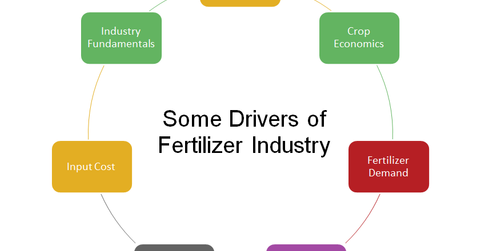Must-know: The key drivers of fertilizer company performance
The importance of the bottom line The performance of any investment over the medium to long term depends on current or future changes in the bottom line, like earnings per share, free cash flow per share, EBITDA (earnings before interest, tax, depreciation, and amortization) per share, and dividend per share. When the bottom line is […]
Oct. 17 2013, Published 3:00 p.m. ET

The importance of the bottom line
The performance of any investment over the medium to long term depends on current or future changes in the bottom line, like earnings per share, free cash flow per share, EBITDA (earnings before interest, tax, depreciation, and amortization) per share, and dividend per share. When the bottom line is rising or expected to rise, the market will bid prices up. Conversely, when it’s expected to deteriorate or is declining, share prices tend to fall.
Earnings drive share prices
Companies’ bottom lines (earnings) depend on revenue and expenses. Higher revenues and lower expenses are positive, while lower revenues and higher expenses are negative for companies and ETFs like CF Industries Holdings Inc. (CF), Potash Corp. (POT), Mosaic Co. (MOS), Agrium Inc. (AGU), and the VanEck Vectors Agribusiness ETF (MOO).
Fertilizer prices
In the fertilizer industry—and pretty much any other commodity companies—revenue depends on fertilizer prices and the quantity of fertilizer companies sell. Fertilizer prices are driven by industry capacity, rivalry (competition among firms), marginal producers’ cost, proximity to customers, inventory, and demand.
Fertilizer demand and purchases
Demand, in turn, is driven by fertilizer prices, crop economics, currencies, cycles, economic activity, and macro factors like subsidy programs. Crop economics consist of factors like crop inventory, crop demand and supply, and crop prices, which depend on economic activity, food consumption, diet patterns, crop yields, nutrient application, weather, plantation, and energy consumption.
The cost of raw-material input
Expenses generally depend on changes in mining costs and fluctuations in raw material prices, which vary by location. Fluctuations in raw material prices or input prices depend on supply and demand dynamics for the specific raw material, which are affected by macro economic activity, weather, and industry trends. Movements in input price can have an impact on fertilizer prices, and therefore demand as well.
As you can see, analyzing factors that affect expense and revenue can become confusing. At Market Realist Inc., we try to break them down. The factors mentioned earlier aren’t comprehensive and as detailed as they could be. But it’s a start. To learn more about these forces that affect fertilizer companies’ revenues and expenses, visit Market Realist Inc.
